Search Engine Optimization-4 Steps to Making Your Search Listings Stand Out on Google
Do you want more click-throughs on your search listings? You can achieve a higher click-through rate (CTR) that drives more qualified traffic to your website by using this one tactic: increasing the size of your Search Engine Results Pages (SERP) listing.
Most SERP listings look like this:

Competition in SERPs is stiff, especially since Google has rolled out so many changes to its algorithms. These changes push down organic results in favor of images, videos, local searches and ads, so a standard listing like the one above won’t do anymore.
You need to supersize that listing. Here are the 4 steps that will help you do that.
Step #1: Write a full and seductive meta description
Meta descriptions get ignored a lot in the world of SEO. Sure, a keyword rich meta description may not be as significant of a factor in search ranking as back links or social signals, but it can play many other influential roles, like bumping CTR on SERPs.
That’s why it pays to optimize meta description. But what makes a great meta description? And how can you write one so that it stands out on Google’s results?
Here are some tactics:
- Avoid small meta descriptions – You’ve got 160 characters to play with. So, try to use every one of those characters if you can. At least write enough content to get to two lines (one line is roughly 80 characters, depending on the size of the words.)
- Include a compelling call to action – Inside that meta description, you need to persuade people to click through:
- Start the tag with an action verb: “Discover why…” or “Read about the…”
- End with action: “Read more…” or “Find out now…”
- Ask a question: “Ever wondered…?” or “What would you do if…?”
- Use a cliffhanger – Your next tip is to borrow a trick from soap operas and end the meta description with suspense: “You’ll never believe what happened next.”
- Use keywords – If words in the user’s search query match words in your title or description, these words will be highlighted, bringing even more attention to your listing.
Beefing up your meta description is an easy way to help your search listings stand out on Google.
Step #2: Create dual rankings
Have you ever done a search and found on the first page of SERPs two results that lead back to the same domain? It might look something like this:
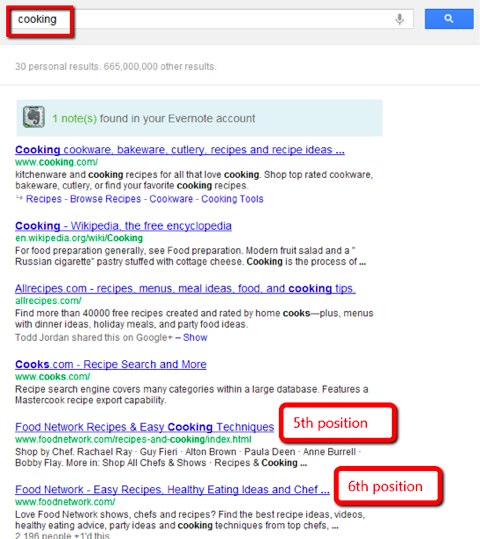
That’s what you get when you search for the keyword “cooking.” The Food Network might think they are pretty lucky to optimize two relevant pages and land those positions so close to each other.
But really what’s going on is that Google links pages from the same domain together when they are both on the same SERP.
Let me explain. Let’s say you have a domain page sitting at the number four position on the first SERP and another page sitting at the number eleven position on page two. If you optimize that lower ranking page and manage to get it to the first page of SERP, Google will then bump it up to the fifth position.
The CTR benefits will skyrocket. Look at the difference between number 10 and 11:
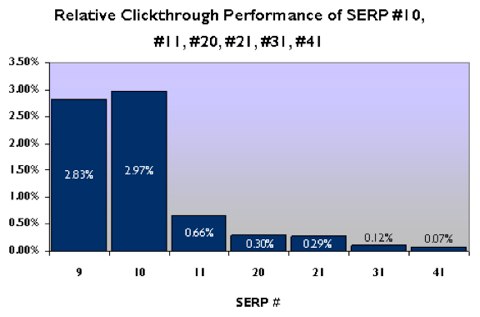
Now look at the results for the top 10:
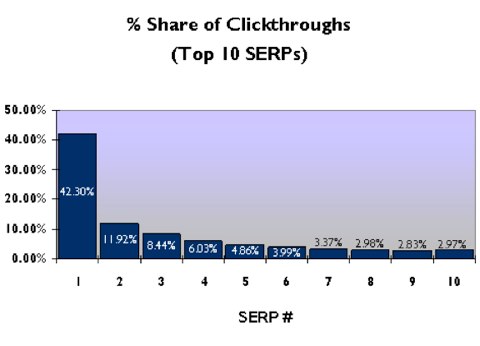
So, it pays to bump that number 11 to a 4, 5 or 6.
Here’s how I would do this strategy:
- Start with the title and description tag – Try to match keywords on the lower ranking page to the words you used in the higher ranking page. Do not write a duplicate title or meta description. The content must be unique but relevant to the keyword.
- Evaluate on–page optimization – Examine the higher ranking page, note the keyword placement in the headers and copy. Revise the lower ranking page to mirror the higher ranking one, but, again, keep the content unique. You do not want to duplicate content.
- Map internal links to the lower ranking page – Drive links from inside your site to the lower ranking page. The key is to use keyword-rich anchor texts. You can create new pages, but often it’s easier to identify pages that share a page’s category label and then link out from there. That way you get the added benefit of updating older pages.
- Drive outside links to lower ranking page – There are several tactics to doing this:
- Volunteer to write guest posts for authoritative sites and then drive one or two keyword-rich anchor text links back to the lower ranking page.
- Find dead links on a site that could point to your page. Suggest this to the webmaster. You can find dead links on a website with this tool at W3C.
- Get links from government sites by emailing relevant ones asking for a link.
All you have to do is get that lower ranking page onto the first page, which is a lot easier than getting a page to the 1st, 2nd or 3rd position. So, just a few links may be enough to nudge a page from the 11th or 12th position to the 10th position.
Step #3: Leverage rich snippets
One of the best new developments to come out of Google that can benefit your search listings are the rich snippets. Rich snippets are great for several things:
Recipes (search query: “oatmeal cookies recipe”)

Business locations (search query: “car alarms”)

Products (search query “otter boxes”)

Events (search query “sasquatch festival”)
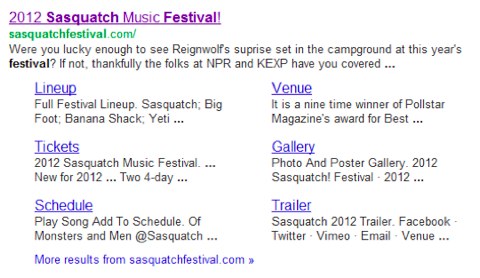
As you can see in the top two examples where I used a generic search query, the listings jump out for several reasons:
- The keyword is highlighted in each circumstance.
- The 5-star ratings will also jump out from among the competing listings. That star rating also adds another line to the listing, so even if the rating was low, it would still stick out.
- And, obviously, the car alarm example stands out because of the list of locations, which I actually cut off.
The other two examples stand out because of the sitelinks (which I’ll talk about more below), increasing the listing size.
There are some great guides out there for helping you get started with rich snippets. Check these out to learn more:
- About rich snippets and structured data (Google Webmasters)
- Visual Guide to Rich Snippets (SEOmoz)
- How to Use Rich Snippets, Structured Markup for High-Powered SEO (Search Engine Land)
Step #4: Get sitelinks
Sitelinks are the links underneath your root domain listing that are basically an expansion of your site based on clean navigation and a simple site structure.
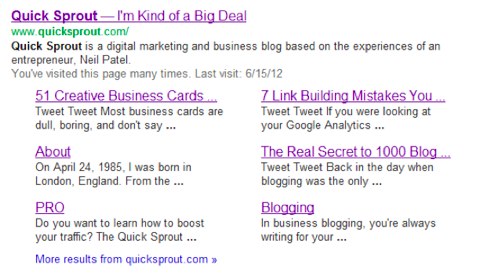
According to Google, sitelinks are automated and will only be displayed if Google thinks they are useful to search users. You can use some best practices to influence your chances of getting sitelinks:
- Create a Google Webmaster account – If you haven’t yet, jump over to Google and set up a Webmaster account for your blog or website. The process is simple and will take about 24 hours on Google’s end. This process will help you accomplish the following (also important in getting sitelinks):
- Submit URL
- Submit site map
- Reconsider your site – If you’ve completed all of the following tasks and believe that you deserve sitelinks, you can ask Google to review your site.
- Remove broken links – If you are using WordPress, use the Broken Link Checker plugin to find your broken links.
- Remove HTML errors – Use a tool like W3C HTML Validation Service to search your site and identify all of the errors in tags and codes. Once you’ve identified these errors, eliminate them.
- Remove CSS errors – The same tool that will identify your HTML errors will also identify your CSS errors.
- Create great content – As you can see above, some of my blog posts have been pulled to be used in the sitelinks. This is because those pages are popular and have lots of links pointing to them and a high number of social signals, which occurred because my content is detailed and advanced.
- Create linkbait – You can also use linkbait content to attract links and then land that page in the sitelinks.
- Attract backlinks with relevant anchor text – Backlinks are the backbone of search, so drive external links to hero pages. These hero pages are the pages you want to show up in the site links.
- Increase organic search traffic – The more traffic you can get from organic search results, the more relevant Google will view your pages. Use these tactics to improve your search results CTR.
- Simple navigation – Mashable’s sitelinks, for the most part, are built from its simple navigation structure (links at the top of the page).

Comments (0)